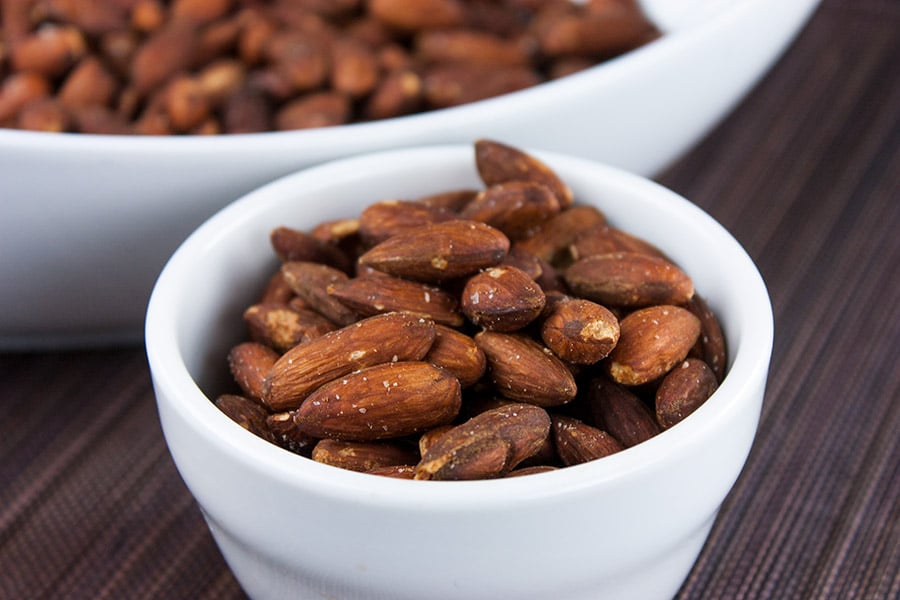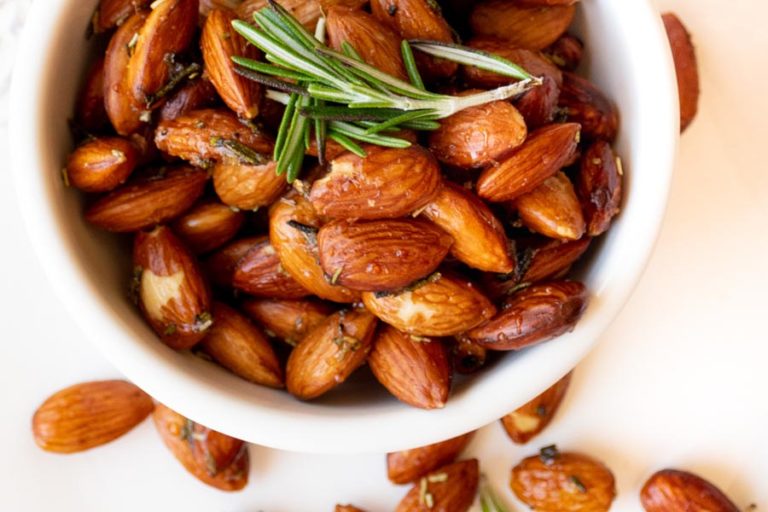Step into the world of culinary delights as we explore the art of roasting almonds, transforming them into a symphony of flavor and nutrition. From their remarkable health benefits to their versatility in various culinary creations, roasted almonds are a culinary treasure waiting to be discovered.
Embark on a journey of culinary exploration as we unveil the secrets of selecting the finest almonds, mastering different roasting techniques, and unlocking a world of flavor variations. Discover how roasted almonds can elevate your favorite dishes, from salads and yogurt parfaits to homemade granola bars and decadent desserts.
Health Benefits of Roasted Almonds

Roasted almonds are a delicious and nutritious snack packed with essential vitamins, minerals, and antioxidants. They offer a range of health benefits, including promoting heart health, managing blood sugar levels, and reducing the risk of chronic diseases.
Nutritional Value of Roasted Almonds
Roasted almonds are rich in monounsaturated fats, protein, fiber, magnesium, calcium, iron, zinc, and vitamin E. They also contain antioxidants like flavonoids and phenolic acids.
Heart Health
The monounsaturated fats and antioxidants in roasted almonds help lower LDL (bad) cholesterol and increase HDL (good) cholesterol, reducing the risk of heart disease and stroke.
Blood Sugar Control
Roasted almonds have a low glycemic index, meaning they release sugar slowly into the bloodstream, helping to prevent blood sugar spikes and crashes. This makes them a good snack for people with diabetes or prediabetes.
Chronic Disease Prevention
The antioxidants in roasted almonds help protect cells from damage, reducing the risk of chronic diseases like cancer, Alzheimer’s disease, and Parkinson’s disease.
Supporting Research
- A study published in the “Journal of the American Heart Association” found that eating almonds regularly can lower LDL cholesterol and improve heart health.
- A study published in the “British Journal of Nutrition” showed that almonds can help manage blood sugar levels and reduce the risk of type 2 diabetes.
- A study published in the “Journal of Alzheimer’s Disease” found that almonds may help protect against Alzheimer’s disease by reducing inflammation and oxidative stress.
Selecting and Preparing Almonds for Roasting
When choosing almonds for roasting, freshness is key. Look for almonds that are plump, firm, and free of blemishes or discoloration. Avoid almonds that are shriveled or have a rancid smell. Regarding variety, there are several popular options to choose from, such as Nonpareil, Carmel, and Mission almonds.
Each variety has its unique flavor profile and texture.If you have specific dietary requirements, such as a preference for organic or unsalted almonds, be sure to check the packaging carefully before purchasing. Almonds can also be purchased in bulk, which can be more cost-effective if you plan to roast them frequently.Before
roasting, it’s important to properly clean and sort the almonds. This helps ensure even cooking and optimal flavor. Begin by removing any visible debris or foreign objects from the almonds. Then, sort the almonds by size to ensure they roast evenly.
Smaller almonds may need to be roasted for a shorter amount of time than larger ones.Soaking almonds before roasting is an optional step, but it can enhance their flavor and nutritional value. Soaking almonds activates enzymes that break down the phytic acid, which can interfere with the absorption of certain nutrients.
To activate almonds, place them in a bowl or container filled with cold water and let them soak for 8-12 hours or overnight. After soaking, drain the almonds and rinse them thoroughly before roasting.
Roasting Techniques and Flavor Variations
Discover the diverse roasting methods and flavor combinations to create your perfect batch of healthy roasted almonds. Experiment with different techniques, temperatures, and seasonings to craft a snack that suits your taste preferences.
Oven Roasting
The traditional method for roasting almonds, oven roasting offers a simple and effective way to achieve a crispy texture and nutty flavor. Preheat your oven to 350°F (175°C) and spread the almonds evenly on a baking sheet. Roast for 10-15 minutes, stirring occasionally, until the almonds are golden brown and fragrant.
For a crunchier result, roast for a few minutes longer.
Stovetop Roasting
If you’re looking for a more hands-on approach, stovetop roasting allows you to closely monitor the almonds as they roast. Heat a large skillet over medium heat and add the almonds. Stir continuously for 5-7 minutes, until the almonds are evenly browned.
Be careful not to burn the almonds, as they can quickly go from toasted to burnt.
Air Fryer Roasting
For a healthier and more convenient option, air fryer roasting yields crispy almonds with minimal oil. Preheat your air fryer to 350°F (175°C) and place the almonds in a single layer in the air fryer basket. Roast for 5-7 minutes, shaking the basket occasionally, until the almonds are golden brown.
Enjoy guilt-free snacking with this low-fat alternative.
Flavor Variations
Elevate your roasted almonds with a variety of flavor combinations. Before roasting, toss the almonds with a mixture of herbs, spices, or seasonings to create a customized snack. Garlic powder, chili powder, smoked paprika, cumin, and curry powder are popular choices that add a savory touch.
For a sweeter treat, try cinnamon, nutmeg, or cocoa powder. Experiment with different combinations to discover your favorite flavor profile.
Achieving the Perfect Roast

Mastering the art of roasting almonds requires careful monitoring and attention to detail. Overcooking or burning can compromise their flavor and nutritional value, while under-roasting may leave them chewy and bland. Understanding the visual cues, sensory indicators, and the impact of roasting time and temperature will guide you towards achieving perfectly roasted almonds.
Visual Cues
- Color: As almonds roast, they undergo a gradual color transformation. Initially pale, they deepen in hue, transitioning from light golden brown to a rich, amber shade. Avoid allowing them to darken excessively, as this may indicate over-roasting.
- Texture: Perfectly roasted almonds should exhibit a slightly crispy exterior and a tender, yet firm interior. Over-roasted almonds become brittle and crumbly, while under-roasted ones remain soft and pliable.
Sensory Indicators
- Aroma: The roasting process releases a distinctive nutty fragrance that intensifies as the almonds brown. A pleasant, toasty aroma signifies that the almonds are nearing the desired doneness. A burnt smell, however, is an indication of over-roasting.
- Sound: As almonds roast, they emit a series of subtle popping sounds. These sounds indicate the release of moisture and the formation of air pockets within the almonds. A continuous crackling sound suggests that the almonds are reaching their peak roast.
Roasting Time and Temperature
The duration and temperature of roasting significantly influence the flavor and nutritional value of almonds. Higher temperatures and longer roasting times result in a more pronounced roasted flavor, while lower temperatures and shorter durations yield a milder flavor. Additionally, roasting at higher temperatures for extended periods may diminish the almonds’ nutritional content.
Experiment with different roasting times and temperatures to discover your preferred flavor profile. However, as a general guideline, roasting almonds at 350°F (175°C) for approximately 10-15 minutes often produces optimal results.
Storing and Using Roasted Almonds
Proper storage techniques ensure that your roasted almonds remain fresh and flavorful. Store them in airtight containers to prevent moisture and oxygen from entering, which can compromise their quality. Choose containers with tight-fitting lids, such as glass jars with airtight seals or resealable plastic bags.
Keep the containers in a cool, dry place away from direct sunlight to maintain the almonds’ optimal flavor and texture.
Creative Ways to Incorporate Roasted Almonds
Roasted almonds can be incorporated into various dishes and snacks to add a crunchy texture and nutty flavor. Here are some creative ideas:
- Salads: Sprinkle roasted almonds on top of your favorite salads for an added crunch and protein boost.
- Yogurt Parfaits: Layer roasted almonds with yogurt, fresh fruits, and granola for a delicious and healthy parfait.
- Trail Mixes: Create your own trail mix by combining roasted almonds with dried fruits, nuts, and seeds.
- Homemade Granola Bars: Add roasted almonds to your homemade granola bars for a satisfying snack.
Using Roasted Almonds as a Topping
Roasted almonds can be used as a topping for various desserts, baked goods, and main courses. Here are some ideas:
- Desserts: Sprinkle roasted almonds on top of ice cream, cakes, pies, and other desserts for a crunchy topping.
- Baked Goods: Add roasted almonds to muffins, cookies, breads, and other baked goods for an extra layer of flavor and texture.
- Main Courses: Use roasted almonds as a topping for grilled fish, chicken, or vegetables for a nutty and savory touch.
Closure
As we conclude our culinary journey, let the symphony of roasted almonds continue to inspire your culinary creations. Experiment with different flavor combinations, explore new recipes, and let your taste buds embark on a delightful adventure. Embrace the versatility of roasted almonds and transform them into culinary masterpieces that nourish your body and soul.
Common Queries
What is the recommended storage method for roasted almonds?
Store roasted almonds in airtight containers at room temperature for up to two weeks or in the refrigerator for up to six months to maintain their freshness and flavor.
Can I use roasted almonds as a topping for desserts?
Absolutely! Roasted almonds add a delightful crunch and nutty flavor to desserts such as ice cream, cakes, and pies. They also make an elegant garnish for various sweet treats.
Are roasted almonds a good source of protein?
Yes, roasted almonds are a plant-based source of protein, providing approximately 6 grams of protein per serving. They are a nutritious snack or addition to meals for vegetarians and vegans.
